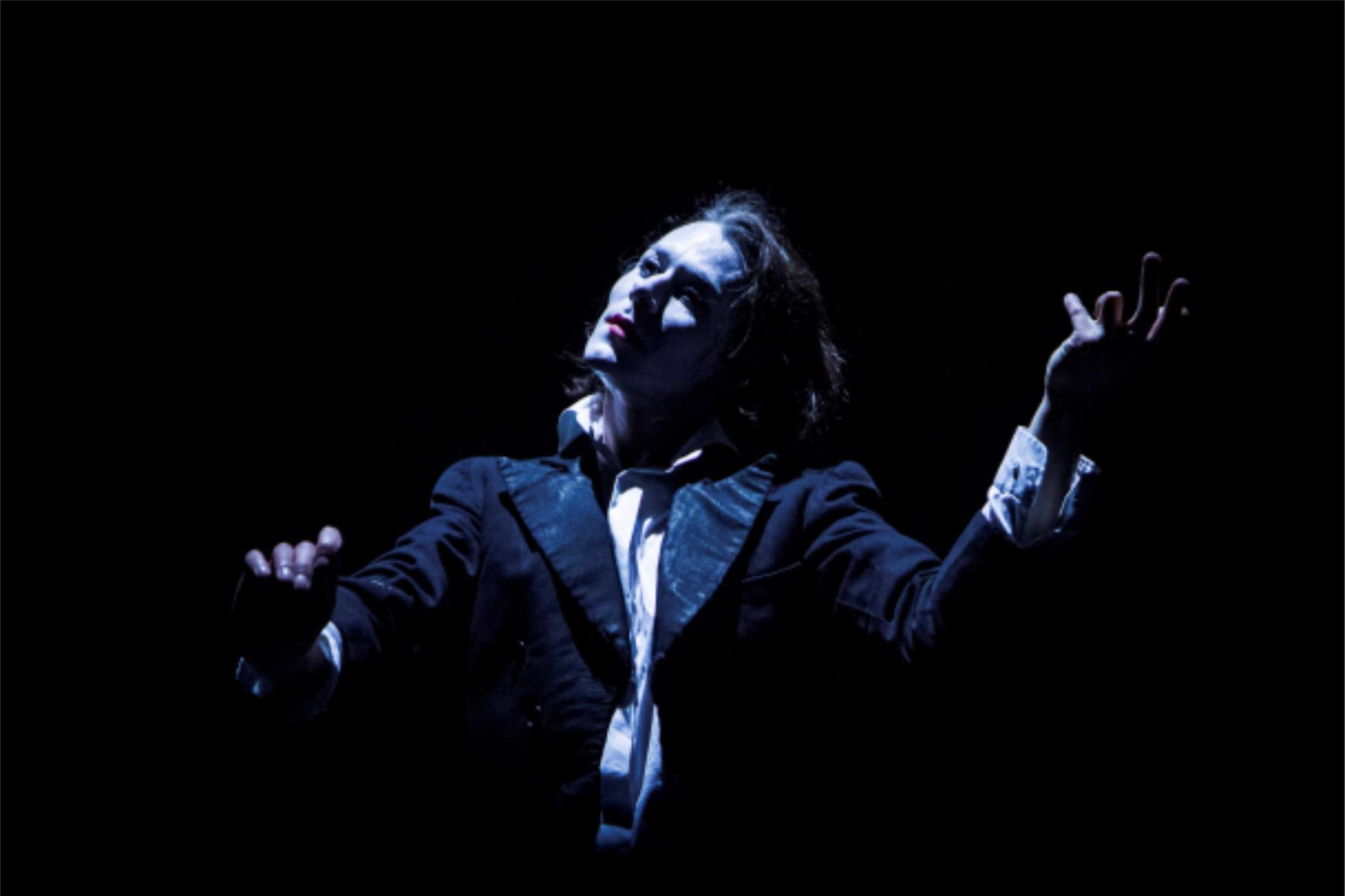 To transform ideas into a piece is just one side of the coin. But how to reflect a piece, how to think and write about it? There are opinions that anyone lacking practical experience should not write about mime theatre. What is your view and how is it possible to “talk about silence”?
To talk means to make poetry. Thomas Leadhart (Decroux’s pupil - editor’s note) said that theorists are those who sit, and artists are those who stand. But it is desirable for modern theorists to be able to sit as well as stand – which is true. On the other hand, I must admit that I got to understand movement mainly through my own practice at Duncan Centre Conservatory, where I was invited by Eva Blažíčková to teach history of dance – like with pantomime, I had to go deep into the study of history of dance to be able to teach it. Before I had been interested in dance art but and had never studied it theoretically. And at Duncan Centre, students’ dance etudes and parts of choreographies were presented all the time. And that was the place where a person so “paper-bound” as me learned to understand movement.
A common theorist just doesn’t understand if a gesture is executed with tension or in release. I’m convinced that in our field – when I write a review, for instance – I can tell my impressions and as a sensible person put my feelings on paper. On the other hand, the experience in movement-reading must be present. And thirdly – it is necessary to view the piece in some context, and not just within the given field of art. The research in pantomime has been for many years affected by the misconception that it should focus on its own subjects, without considering the genre as a part of something bigger. But that is essential because pantomime is always in between something – between dance and drama, between poetry and clownery, circus etc.
PhDr. Ladislava Petišková (born 3 January 1943) – theatre theorist, editor, pedagogue and critic. She graduated from the Department of Theatre Science of the Faculty of Arts, Charles University (1969) and obtained a certificate from the International School of Theatre Anthropology ISTA Eugenio Barba in Portugal (1998). Until 1999 she was a member of the Cabinet of Czech Theatre Studies of the Theatre Institute, from 2001 to 2006 she was the chair of the Theatre Theory Company. She teaches history and theory of dance/physical theatre at HAMU and at Duncan Centre Conservatory, and works as a publicist and theorist of physical theatre.
To transform ideas into a piece is just one side of the coin. But how to reflect a piece, how to think and write about it? There are opinions that anyone lacking practical experience should not write about mime theatre. What is your view and how is it possible to “talk about silence”?
To talk means to make poetry. Thomas Leadhart (Decroux’s pupil - editor’s note) said that theorists are those who sit, and artists are those who stand. But it is desirable for modern theorists to be able to sit as well as stand – which is true. On the other hand, I must admit that I got to understand movement mainly through my own practice at Duncan Centre Conservatory, where I was invited by Eva Blažíčková to teach history of dance – like with pantomime, I had to go deep into the study of history of dance to be able to teach it. Before I had been interested in dance art but and had never studied it theoretically. And at Duncan Centre, students’ dance etudes and parts of choreographies were presented all the time. And that was the place where a person so “paper-bound” as me learned to understand movement.
A common theorist just doesn’t understand if a gesture is executed with tension or in release. I’m convinced that in our field – when I write a review, for instance – I can tell my impressions and as a sensible person put my feelings on paper. On the other hand, the experience in movement-reading must be present. And thirdly – it is necessary to view the piece in some context, and not just within the given field of art. The research in pantomime has been for many years affected by the misconception that it should focus on its own subjects, without considering the genre as a part of something bigger. But that is essential because pantomime is always in between something – between dance and drama, between poetry and clownery, circus etc.
PhDr. Ladislava Petišková (born 3 January 1943) – theatre theorist, editor, pedagogue and critic. She graduated from the Department of Theatre Science of the Faculty of Arts, Charles University (1969) and obtained a certificate from the International School of Theatre Anthropology ISTA Eugenio Barba in Portugal (1998). Until 1999 she was a member of the Cabinet of Czech Theatre Studies of the Theatre Institute, from 2001 to 2006 she was the chair of the Theatre Theory Company. She teaches history and theory of dance/physical theatre at HAMU and at Duncan Centre Conservatory, and works as a publicist and theorist of physical theatre.
Ladislava Petišková: “Pantomime is about thinking and feeling.”
Interviews
 To transform ideas into a piece is just one side of the coin. But how to reflect a piece, how to think and write about it? There are opinions that anyone lacking practical experience should not write about mime theatre. What is your view and how is it possible to “talk about silence”?
To talk means to make poetry. Thomas Leadhart (Decroux’s pupil - editor’s note) said that theorists are those who sit, and artists are those who stand. But it is desirable for modern theorists to be able to sit as well as stand – which is true. On the other hand, I must admit that I got to understand movement mainly through my own practice at Duncan Centre Conservatory, where I was invited by Eva Blažíčková to teach history of dance – like with pantomime, I had to go deep into the study of history of dance to be able to teach it. Before I had been interested in dance art but and had never studied it theoretically. And at Duncan Centre, students’ dance etudes and parts of choreographies were presented all the time. And that was the place where a person so “paper-bound” as me learned to understand movement.
A common theorist just doesn’t understand if a gesture is executed with tension or in release. I’m convinced that in our field – when I write a review, for instance – I can tell my impressions and as a sensible person put my feelings on paper. On the other hand, the experience in movement-reading must be present. And thirdly – it is necessary to view the piece in some context, and not just within the given field of art. The research in pantomime has been for many years affected by the misconception that it should focus on its own subjects, without considering the genre as a part of something bigger. But that is essential because pantomime is always in between something – between dance and drama, between poetry and clownery, circus etc.
PhDr. Ladislava Petišková (born 3 January 1943) – theatre theorist, editor, pedagogue and critic. She graduated from the Department of Theatre Science of the Faculty of Arts, Charles University (1969) and obtained a certificate from the International School of Theatre Anthropology ISTA Eugenio Barba in Portugal (1998). Until 1999 she was a member of the Cabinet of Czech Theatre Studies of the Theatre Institute, from 2001 to 2006 she was the chair of the Theatre Theory Company. She teaches history and theory of dance/physical theatre at HAMU and at Duncan Centre Conservatory, and works as a publicist and theorist of physical theatre.
To transform ideas into a piece is just one side of the coin. But how to reflect a piece, how to think and write about it? There are opinions that anyone lacking practical experience should not write about mime theatre. What is your view and how is it possible to “talk about silence”?
To talk means to make poetry. Thomas Leadhart (Decroux’s pupil - editor’s note) said that theorists are those who sit, and artists are those who stand. But it is desirable for modern theorists to be able to sit as well as stand – which is true. On the other hand, I must admit that I got to understand movement mainly through my own practice at Duncan Centre Conservatory, where I was invited by Eva Blažíčková to teach history of dance – like with pantomime, I had to go deep into the study of history of dance to be able to teach it. Before I had been interested in dance art but and had never studied it theoretically. And at Duncan Centre, students’ dance etudes and parts of choreographies were presented all the time. And that was the place where a person so “paper-bound” as me learned to understand movement.
A common theorist just doesn’t understand if a gesture is executed with tension or in release. I’m convinced that in our field – when I write a review, for instance – I can tell my impressions and as a sensible person put my feelings on paper. On the other hand, the experience in movement-reading must be present. And thirdly – it is necessary to view the piece in some context, and not just within the given field of art. The research in pantomime has been for many years affected by the misconception that it should focus on its own subjects, without considering the genre as a part of something bigger. But that is essential because pantomime is always in between something – between dance and drama, between poetry and clownery, circus etc.
PhDr. Ladislava Petišková (born 3 January 1943) – theatre theorist, editor, pedagogue and critic. She graduated from the Department of Theatre Science of the Faculty of Arts, Charles University (1969) and obtained a certificate from the International School of Theatre Anthropology ISTA Eugenio Barba in Portugal (1998). Until 1999 she was a member of the Cabinet of Czech Theatre Studies of the Theatre Institute, from 2001 to 2006 she was the chair of the Theatre Theory Company. She teaches history and theory of dance/physical theatre at HAMU and at Duncan Centre Conservatory, and works as a publicist and theorist of physical theatre.
Diskuze
Přidat komentářMOST POPULAR
-
Tanztage Berlin 2024 — Choreographing Complexity Through Emerging Dance Artists
Reviews -
Rush – Imaginative Retrospective with a Touch of Humour
Reviews -
Taneční aktuality / Czech Dance News is changing to Dance Context
News -
La Strada as a life journey through circus archetypes
Reviews -
Giselle by English National Ballet - rich in all the historical details, yet shallow at times
Reviews




Josef Bartos
Thank you for your thoughts. One got stuck in my mind – that passion makes us different from AI. Just yesterday I read…I am a dance critic. I am a member of an endangered species